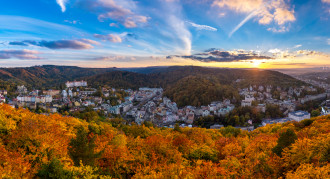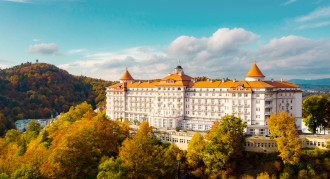31. 1. 2013 | History
The seep of the Zámecký pramen (Castle Spring) first appeared in 1769 below Zámecká věž (Castle Tower) in the historical centre of Karlovy Vary. After performing a chemical analysis of the spring, Karlsbad physician Dr. David Becher proposed the exploitation of the mineral water for balneological purposes. The first arbour was built over the Castle Spring in 1797.
An eruption of the Hot Spring in 1809 caused the Castle Spring to disappear and to reappear only 14 years later. In 1830, a new wooden colonnade designed by architect Josef Esch was built next to the arbour arching over the Castle Spring.
A new Art Nouveau colonnade according to the design of renowned Viennese architect Johann Friedrich Ohmann was constructed on the site in the years 1910 and 1912. The colonnade consisting of three separate structures, i.e. the Lower Castle Spring Colonnade, the Sun Bath, and the Upper Castle Spring Colonnade, was to connect the area above the Castle Spring with the Market Colonnade in order to create a single promenade. In 1913, the rear side of the seep of the Lower Castle Spring was complemented with a monumental Art Nouveau relief of the Spirit of the Springs carved into sinter by Viennese sculptor Wenzel Hejda.
In 2000 and 2001, the dilapidated Castle Colonnade was converted into the Zámecké lázně (Castle Spa) Spa and Wellness Centre designed by architect Alexandr Mikoláš. Today, the Castle Spa is accessible only to its guests. Nevertheless, the arbour with the Upper Castle Spring remains open to the public and the Lower Castle Spring has been diverted to the Market Colonnade.


